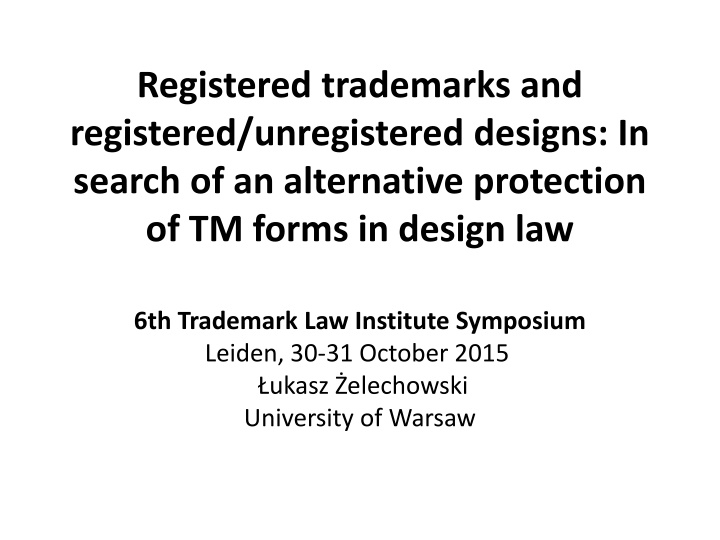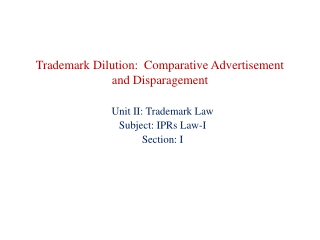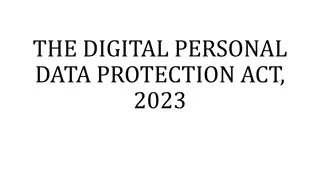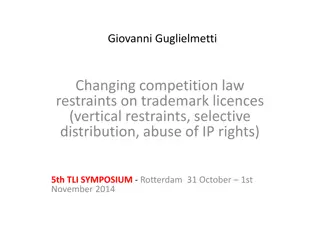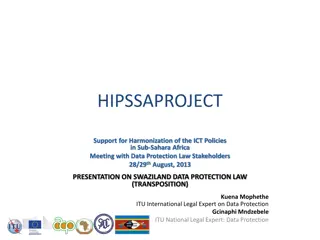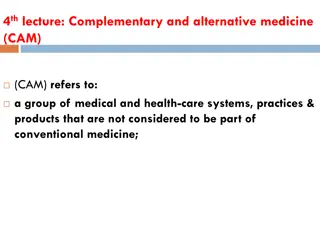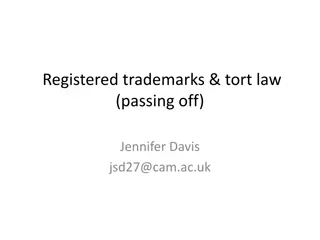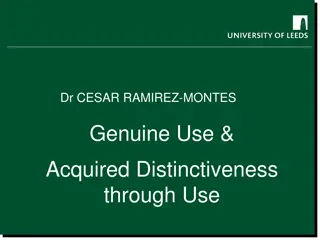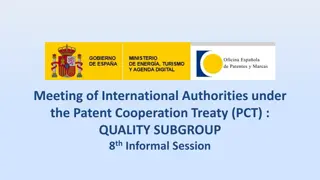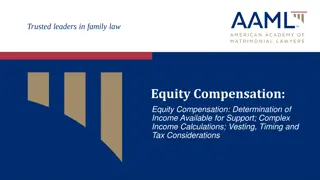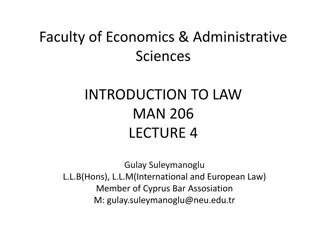Alternative Protection of Trademarks in Design Law: A Study
This study explores the overlap and interaction between registered trademarks, registered/unregistered designs, and the quest for alternative forms of protection within design law. The symposium at the University of Warsaw delves into the complexities and nuances of intellectual property rights, focusing on the 6th Trademark Law Institute Symposium held in Leiden on October 30-31, 2015. The research sheds light on current discussions, challenges, and potential solutions in this evolving legal landscape.
Download Presentation

Please find below an Image/Link to download the presentation.
The content on the website is provided AS IS for your information and personal use only. It may not be sold, licensed, or shared on other websites without obtaining consent from the author.If you encounter any issues during the download, it is possible that the publisher has removed the file from their server.
You are allowed to download the files provided on this website for personal or commercial use, subject to the condition that they are used lawfully. All files are the property of their respective owners.
The content on the website is provided AS IS for your information and personal use only. It may not be sold, licensed, or shared on other websites without obtaining consent from the author.
E N D
Presentation Transcript
Registered trademarks and registered/unregistered designs: In search of an alternative protection of TM forms in design law 6th Trademark Law Institute Symposium Leiden, 30-31 October 2015 ukasz elechowski University of Warsaw
Introduction Restrictive approach towards protection of shapes as TMs due to the strict assessment of distinctiveness of such forms and due to the application of exclusion grounds set out in art 3(1)(e) of the Directive 2008/95 [Art. 7(1)(e) CTMR] Possible greater attractiveness in certain instances of design protection of 2D forms as compared with TM protection Purpose of the presentation: examining alternatives to TM protection in a/m cases in the realm of design law With regard to shapes focus is given to 3D forms excluded from protection due to exclusions contained in art 3(1)(e) of the Directive 2008/95 [Art. 7(1)(e) CTMR]
Exclusions in art 3(1)(e) of the Directive 2008/95 [Art. 7(1)(e) CTMR]: To what extent could design law offer an alternative protection?
Exclusion for shapes resulting from goods themselves TM law: Hauck - intended broadening of the scope of the exclusion "the ground for refusal of registration set out in that provision may apply to a sign which consists exclusively of the shape of a product with one or more essential characteristics which are inherent to the generic function or functions of that product and which consumers may be looking for in the products of competitors" (para. 27) Possible alternative protection in design law? Need to take into account the presence of generic functions as a factor affecting the degree of designer s freedom with the view to assessing individual character of a design
Technical function exclusions in TM and design law - scope TM law: art 3(1)(e)(ii) Directive 2008/95, art. 7(1)(e)(ii) CTMR - signs which consist exclusively of the shape [or another characteristic EU reform compromise text] of goods which is necessary to obtain a technical result Design law: art. 7(1) of the Directive 98/71, art. 8(1) CDR: A design right shall not subsist in features of appearance of a product which are solely dictated by its technical function
Technical function exclusions in TM and design law - rationale TM law: underlying public interest preventing TM law from granting a monopoly on technical solutions or functional characteristics of a product (Philips, paras 78-79; Lego para. 43) Design law: Separation from the field of patent law Recital 10 of the CDR (Recital 14 of the Directive 98/71): Technological innovation should not be hampered by granting design protection to features dictated solely by a technical function. It is understood that this does not entail that a design must have an aesthetic quality.
Technical function exclusions in TM and design law - application What is a functional feature? Establishing "essential characteristics" of a shape Necessary v. solely dictated: Multiplicity-of-forms approach or the "causative" test? TM law - rejection of the multiplicity-of-forms approach (Philips, Lego) Unclear status in design law: In favour of the multiplicity-of-forms approach: opinion of AG Colomer in Philips (para. 34) Rejection of the multiplicity-of-forms approach: BoA Lindner R-690/2007-3 (paras 28-32) Question: Does the technical function exclusion in design law lead to a similar outcome like in TM law or does it lead to a different outcome which narrows the scope of shapes excluded from protection?
Exclusion for shapes giving substantial value to the goods (I) Shapes excluded from TM protection due to the "substantial value" exclusion: Potential eligibility for design protection Rationale for the exclusion in the light of Hauck - preventing potentially indefinite TM protection of objects, which are rather eligible for protection by other IP rights limited in time (para. 19, equalling it with the aim pursued by the technical function exclusion).
Exclusion for shapes giving substantial value to the goods (II) The rationale for this exclusion in the light of Hauck raises various questions concerning among others: Relevance of existing design registrations held by a TM applicant for the assessment of the "substantial value" exclusion? Permanent effect of the "substantial value" exclusion: a too-restrictive tool? (case of developed distinctiveness)
Eligibility of 2D forms for design protection 2D forms applied to tangible goods 2D forms as products: Broad understanding of a "product" including 2D forms, in particular graphic symbols [art. 1(b) of the Directive 98/71, art. 3(b) CDR] "product" means any industrial or handicraft item, including inter alia parts intended to be assembled into a complex product, packaging, get-up, graphic symbols and typographic typefaces, but excluding computer programs
Scope of protection Systems with product-unrelated scope of the design right [the CDR: art. 36(6) in conjunction with art. 36(2) and 36(3)(d)] Systems with product-related scope of the design right [art. 105(5) of the Polish Industrial Property Law] Wording: A right in registration of an industrial design is restricted to products of the type for which the application was made. Doubts raised in Polish literature as to the accordance of this provision with the Directive 98/71. Design protection of 2D forms "as such" as compared to "goods-related" protection by TM law: Is there a need for some "actual" product relevance with regard to the scope of protection of 2D forms in design law?
2D forms as unregistered designs Availability of protection of 2D forms as unregistered Community designs under the CDR Dilemmas Difficulties in establishing whether a plain 2D form is a complete appearance of a product Difficulties in a separation of 2D forms, which were made available to the public in tangible products, as a standalone form independent from other elements of the product, in particular its shape UK no protection of surface decoration as unregistered design
